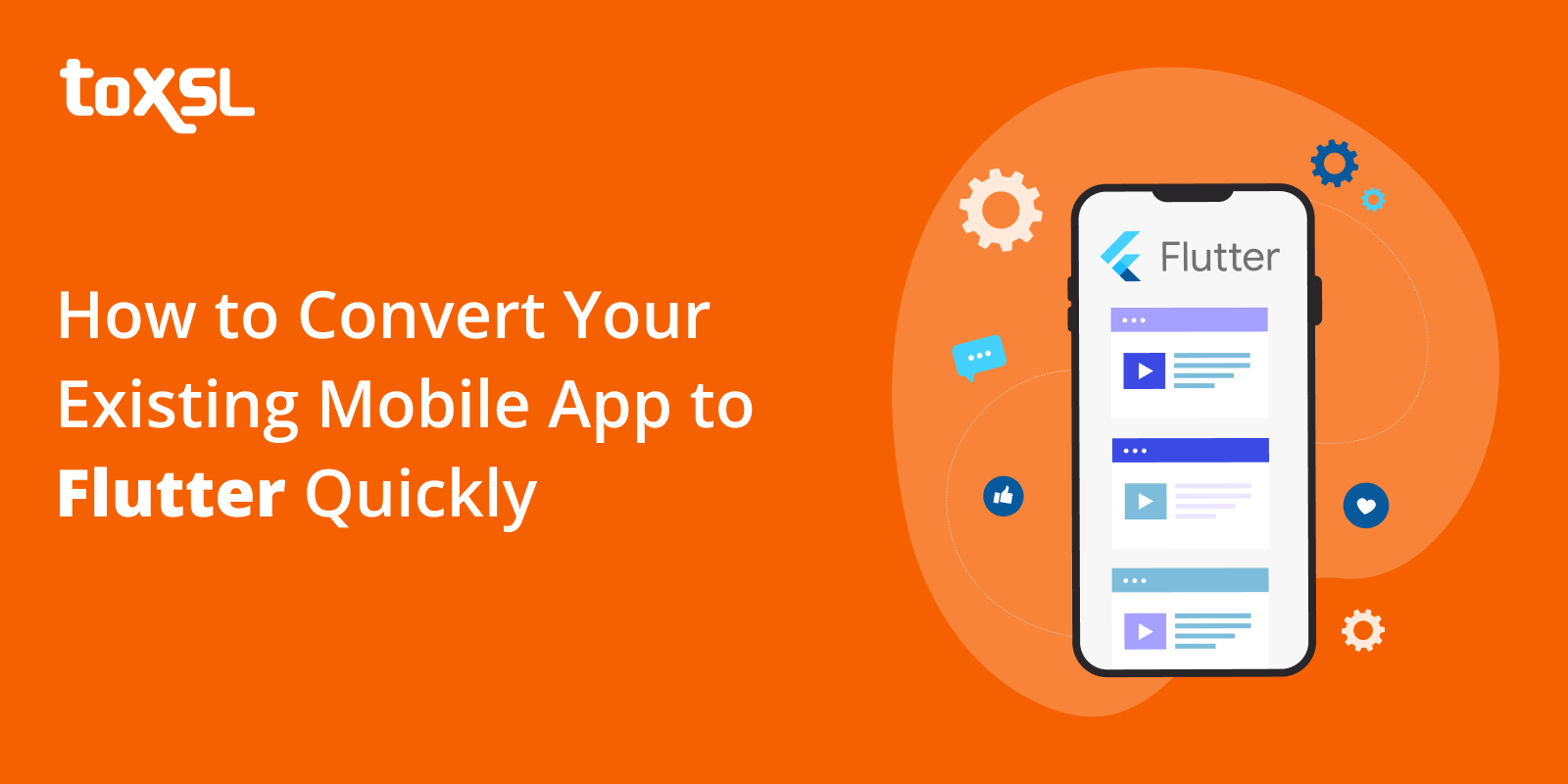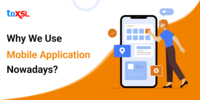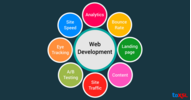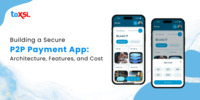- Feb 28, 2025
Share this post on:

Since 2017, Flutter has gained immense popularity among developers. Flutter is one of the most interesting and reliable technologies that help businesses develop apps faster and give enough time to market them. It allows developers to develop effective and high-quality modern apps for Android, iOS, and future platforms using a unified codebase.
With time, Flutter has become the most intriguing technology and everyone in the development community is talking about its efficiency, speed, and quality. Nowadays, as we see there is a rise in cross-platform app development frameworks. Hence, converting existing Android and iOS apps to Flutter has become an efficient choice for developers, saving time and cost.
According to Stack Overflow, Android continues to dominate the mobile market with an impressive 72% market share, while iOS maintains a substantial 27% share.
Now if developers have to develop code for single-single platforms, it is a great deal. Why? Because it will take their time and cost. So, this is where Flutter saves them the pain, by offering them the functionality where they can create the same codebase for all platforms.
Not that, developers can easily convert their existing app to Flutter. But the question is How? How do they convert the existing app to Flutter?
Key Takeaway
Flutter simplifies custom mobile app development by using a unified codebase for Android, iOS, and other platforms. Converting existing apps to Flutter saves time and costs while maintaining high quality.
Converting an Android App to Flutter
Let us discuss the process of converting an existing Android app to Flutter, ensuring a smooth transition and maintaining the app’s functionality.
Step: 1 Understand the basics of Flutter
Before converting an Android app to Flutter, it’s essential to understand the basics of Flutter, including its architecture, widgets, and state management. This knowledge will help you better understand the conversion process and ensure a successful transition.
Step: 2 Analyze the current Android app
Before starting the conversion process, analyze the existing Android app to understand its structure, dependencies, and third-party libraries. This analysis will help you identify any potential compatibility issues and ensure a smooth transition to Flutter.
Step: 3 Create a Flutter project
Create a new Flutter project using the command-line interface (CLI) or through an integrated development environment (IDE) like Android Studio or Visual Studio Code. Make sure to set up the necessary dependencies, such as the Flutter SDK and required plugins.
Step: 4 Migrate the app’s code to Flutter
Start by migrating the app’s code to Flutter. Begin with the main entry point of the app, such as the Activity or Fragment class, and gradually work through the different components, such as layouts, views, and other UI elements. Use Flutter’s widgets and APIs to recreate the app’s functionality in Flutter.
Step: 5. Handle platform-specific code
Some parts of the app may require platform-specific code, such as accessing device-specific features or implementing platform-specific APIs. In these cases, use Flutter’s platform channels and plugins to handle platform-specific code.
Step: 6 Migrate the app’s data layer
Migrate the app’s data layer, including local storage, remote APIs, and other data sources, to Flutter. This may involve updating the app’s dependencies, such as moving from SQLite to a Flutter-compatible database or modifying existing REST APIs to support Flutter’s requirements.
Step: 7 Test and refactor the app
Once the app’s code has been migrated to Flutter, test the app to ensure its functionality remains intact. Address any issues or bugs, and refactor the code as necessary to improve its structure and maintainability.
Step: 8 Optimize performance
Optimize the app’s performance by analyzing its rendering, layout, and painting performance. Use Flutter’s built-in tools, such as the DevTools profiler, to identify performance bottlenecks and optimize the app accordingly.
Step: 9 Prepare the app for deployment
Once the app has been migrated and optimized, prepare it for deployment by setting up build configurations, updating app icons and splash screens, and implementing any necessary app store optimizations.
Step: 10 Deploy the app
Deploy the Flutter-converted app to the Google Play Store or other app distribution platforms. Test the app on real devices to ensure it functions as expected and make any final adjustments before releasing it to the public.
Converting an iOS App to Flutter
Let us discuss the steps involved in converting an iOS app to Flutter.
Step 1: Analyze the iOS App
Before starting the conversion process, it is essential to analyze the iOS app to identify its structure, dependencies, and any potential compatibility issues with Flutter. This will help developers understand the level of work required to migrate the app and identify any areas that may need additional attention.
Step 2: Set Up the Flutter Environment
custom app developers should ensure they have the necessary tools and environments set up to work with Flutter, including installing Flutter SDK, setting up the IDE (such as Visual Studio Code or Android Studio), and configuring the Flutter plugin for Xcode.
Step 3: Create a Flutter Project
Once the Flutter environment is set up, developers can create a new Flutter project and add the necessary dependencies to replicate the functionality of the iOS app. This may involve integrating third-party packages or creating custom widgets to mimic the existing app’s design.
Step 4: Migrate the Codebase
Developers can now begin migrating the iOS app’s codebase to Flutter. This process involves converting Swift or Objective-C code to Dart, Flutter’s programming language, and rewriting the app’s user interface using Flutter’s widgets and layouts. Additionally, developers should ensure that the app’s data persistence, networking, and other backend services are compatible with Flutter.
Step 5: Test and Optimize
After migrating the codebase, developers should test the app thoroughly to ensure it functions correctly and meets the desired performance standards. This may involve fixing any bugs, optimizing the app’s performance, and ensuring that the app’s design and user experience are consistent with the original custom iOS app.
Step 6: Deploy the Flutter App
Once the app is fully functional and optimized, developers can deploy it to the appropriate app stores. This may involve setting up app store accounts, generating signing keys, and submitting the app for review.
How to integrate a Flutter module into an Android/iOS project
The steps involved in the integration of the Flutter module into an Android/iOS project are as follows:
1. New Flutter Module
To begin, you must understand the process of creating a new Flutter module. The Flutter “create command” is the primary tool used to generate a new Flutter project. Hence, create a new Flutter module using the Flutter create command. This will create a new Flutter project that you can use as a module in your existing project.
2. Add Module to the Projects
To incorporate a module into your current Android or iOS project, you must add it as a dependency. In Android, this process entails including the module as a sub-project in your project’s “settings.gradle” file and subsequently adding the module as a dependency in your project’s “build. gradle” file. In iOS, you will need to add the module as a dependency in your project’s “Podfile.”
3. Module Configuration
Once the module is integrated into your project, you must customize it to work harmoniously with your existing project. This may entail adjusting aspects such as the module’s build settings, linking to native code, and configuring the module’s starting point.
4. Use the Module
Finally, you can incorporate the Flutter module into your project by calling its APIs from your native code. This will enable you to leverage the functionality provided by the Flutter module in your existing project.
However, it is crucial to acknowledge that the specific steps required for integrating a Flutter module will vary depending on your particular project and the modules you are working with. Consequently, you must refer to the documentation for your specific module and platform to guarantee you are adhering to the correct procedures.
To Summarize
Developing mobile applications can be a daunting task, but thankfully, there are tools available that can help ease the process. Flutter is one such tool that streamlines updates and creates user-friendly apps with minimal effort. Additionally, its developer-friendly features simplify mobile app development. However, having experience in mobile development is still necessary for optimal use of Flutter. That's where our expertise comes in. If you are looking for a mobile app development company in dubai to convert your existing mobile app to Flutter, feel free to contact us.
Frequently Asked Questions (FAQs)
1. How do I convert an Android app to iOS?
Ans: iOS and Android are two completely different operating systems. As a result, the apps that run on them are created with extremely special frameworks.
The cross-platform app development frameworks, such as Flutter and React Native, made it easier to convert an Android app to an iOS one and vice versa.
With the introduction of cross-platform app development frameworks like Flutter, creating apps for both iOS and Android using a single codebase has become less expensive.
For assistance with converting your Android application to the iOS framework, contact the IT specialists at ToXSL Technologies right now.
2. How can you build mobile apps with Flutter?
Ans: Flutter is a great framework for building mobile apps. It makes it possible to develop quickly, create stunning, responsive designs, and use a single source code base for both iOS and Android. Developers may see changes instantly with the help of hot-reload, which speeds up the development process.
3. Can I use Flutter within my existing app?
Ans: Flutter is designed to be easily integrated into existing apps, whether they are built using native iOS or Android development tools. Here are some ways you can use Flutter within your existing app:
Cross-platform widgets: With Flutter, you can create cross-platform widgets that can be used in both iOS and Android apps. This means you can share the same codebase across different platforms, reducing development time and costs.
Customizable components: Flutter provides a wide range of customizable components that can be easily integrated into your existing app. For example, you can use Flutter's built-in widgets for navigation, buttons, and forms to enhance the user experience.
Reusable code: Flutter's Dart language is designed to be reusable across different platforms, which means you can write code once and use it in multiple apps. This can help reduce maintenance costs and improve development efficiency.












